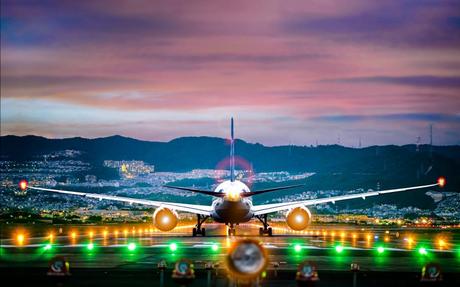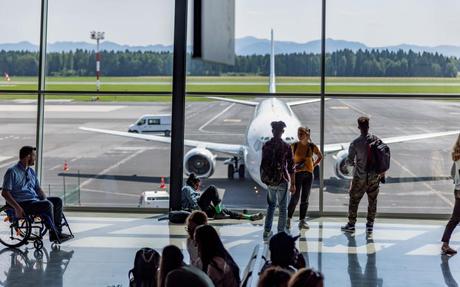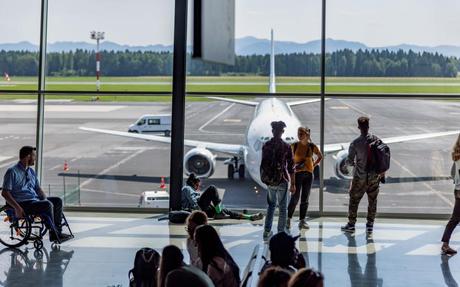
Footage has emerged of a parked passenger plane in Argentina spinning out of control and crashing into a staircase during a storm.
The incident took place on Sunday when a heavy storm and winds of 160 km/h hit Buenos Aires' Aeroparque Jorge Newbery airport. The images show how a staircase and other airport equipment are blown across the asphalt at high speed.
In a statement, Aerolineas Argentinas said: "As a result of the strong storm that mainly affected Aeroparque's operations, 100 flights have been canceled so far, and the same number have suffered delays and rescheduling."
The aircraft suffered damage and the next scheduled flight was canceled while the aircraft was grounded for repairs.
This is an example of the kind of danger on Earth that travelers hardly think about, but for which ground crews are extensively trained. The rare, fiery ways in which a plane can fail mid-flight may appeal more to the imagination, but it is on the runway that incidents and human error are most common.
Raids on the runway
A study by US transportation authorities shows that the number of runway incursions - where an aircraft, vehicle or person is mistakenly on the runway - has increased over time (approximately 1,756 were reported at US airports in the past year) .
Michele Robson, an aviation expert at Turning Left For Less, thinks complicated runway layouts could increase the risk. Incidents involving vehicles are "very rare in this country," she says, "but are more common in other parts of the world." Large airports like Chicago O'Hare are more difficult to navigate: vehicles can inadvertently end up in the path of a taxiing plane, or a pilot can get lost.
Long-haul pilot Charlie Page says he watches for such violations all the time. "We have to be so aware of all the potential dangers," he says. "We are absolutely focused and constantly building a 3D picture of the area in our minds."
In fact, a Chicago Sun Times investigation found that five members of airport staff have been reprimanded for such raids since 2020. In one incident, a vehicle was driven into a 'runway safety area' and remained there while a Korean Air jetline "flew over" it. Another employee was suspended after accidentally driving onto the runway and causing an aborted landing.
The story continues
In both incidents, all passengers and staff were unharmed. But Robson points out that unknown runway layouts, and poor visibility in general, can lead to much more dangerous scenarios.
A consequential accident
Such incidents are now extremely rare, due to one particularly horrific incident. In 1977, a KLM flight took off from Tenerife airport in dense fog while a Pam Am flight was still on the runway, unbeknownst to the pilot. The planes collided, killing 583 people. It was the deadliest non-terrorist-related aviation disaster in history.
As a result of the accident, a whole series of new procedures were initiated to assist air traffic controllers and pilots. Emphasis was placed on the use of English as a common working language, and standard expressions such as "hold position" were introduced for clarification. Cockpit procedures were also tightened - there was speculation that KLM aircraft staff felt unable to challenge the respected pilot, who appeared to take off without permission. Flight crew are now explicitly trained to challenge decisions, regardless of their seniority.
A procedure has also been developed for reduced visibility, such as that in the Tenerife disaster. "Things like lost pilots or other vehicles on the runway are now being picked up by surface radar equipment," says Robson. "Even in poor visibility, a controller can see everything on what looks like a radar display. So if someone comes the wrong way, they don't have to look out the window all the time, it's on the screen."
Another recent event took place in Stansted. A Ryanair plane traveling from Luxembourg collided with a ground vehicle while taxiing to the gate. Footage shows the ambulift - a mobility aid used by disabled passengers - approaching the plane before stopping and trying to reverse.
The action was apparently misjudged. The top of the vehicle is pinched off by the aircraft's wing, apparently resulting in damage to the aircraft.
Due to the relatively low speed of the vehicles involved, raids such as the one in Stansted do not pose a serious threat. Passengers are still required to wear seat belts and the aircraft's body is significantly more resilient than a ground vehicle. Stranger, more social media-friendly incidents, like the widely shared video of a JetBlue plane tipping backward, can feel like troubling incidents involving danger on the ground. But in reality the risk to passengers is very low.
Excursions on the runway
However, the runway can become a more dangerous place during incidents such as the one at Leeds Bradford Airport last month, when a Tui aircraft 'slid off the runway' during heavy rain. Once again, the passengers managed to leave the plane unharmed.
Excursions - where an aircraft deviates from or leaves the runway surface - pose a particular threat. The International Air Transport Association called them "the most common type of accident" in its 2022 safety report. Two years earlier, 24 deaths, 77 seriously injured and six cases of significant aircraft damage were attributed to excursions. The life risk is obviously scary, but airlines are also extremely careful with their costs. Swiss consultancy Safe-Runway GmbH estimates that the direct costs of runway excursions are about $4 billion per year.
Passengers - and the operator - were fortunate that the Tui aircraft did not fall apart during the excursion. Several such incidents have resulted in serious injuries and often extreme damage to the aircraft. In 2000, Southwest Airlines Flight 1455 overran the Burbank Airport runway due to wet weather. He crashed through a fence and eventually came to a stop in front of a gas station. Fortunately, everyone survived, but the plane was written off. It was the first major accident in the airline's history.
Other excursions have proven more deadly. In 2020, a Pegasus Airlines flight overran the runway while landing at Istanbul-Sabiha Gökçen International Airport in bad weather conditions and broke into several pieces. Three passengers were killed.


Airport restriction
Yet overall, aviation accidents remain rare and declining. Airports use curiously named instruments such as skidometers to measure runway friction and monitor water levels, meaning weather conditions are closely monitored. And while it often seems dramatic, pilots can respond to any perceived danger on the ground right up to the moment of landing.
"If there is another aircraft or vehicle on the runway, a pilot will abort the landing," Robson said. "The same could happen if the track surface is deemed unsafe. A pilot may even touch the wheels before going full speed and climbing back to a certain altitude because he is not happy with the conditions. Passengers may feel quite alarmed by the sudden shift, but it is actually a safety measure."
And while you may be eager to get your vacation off to a flying start as soon as the tires hit the tarmac, safety concerns persist until the plane comes to a complete stop. If the Stansted incident reveals anything, it's that airlines really mean it when they advise you to fasten your seat belt.
